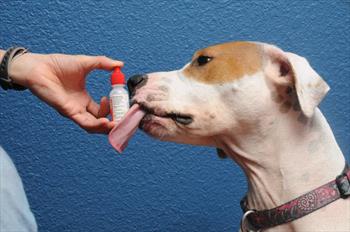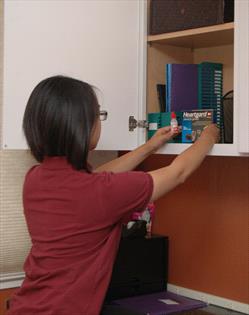Question:
I recently saw you speak at the IAABC and enjoyed your talk. I had a question regarding the tips from your newsletter about administering eye drops. I thought your advice seemed great and passed it on to the ophthalmology group I work with as a vet tech. Both the doctors and the techs had major concerns about contamination to the bottle by putting treats directly on the bottle and they also had a problem with potentially teaching your dog that it is okay to lick/chew on eye (or other med) bottles. What are your thoughts on these objections?
Thanks! I appreciate your time.
Jocelyn from Massachusetts
Answer:
Good questions and with easy solutions to their concerns.
Thanks for taking the time to share the newsletter with your colleagues and then to express their concerns so that I could address them in my blog. In the newsletter, Behavior Bytes Volume 5, I showed several techniques for training dogs to love getting drops in their eyes. One of those methods involved putting food on the a bottle that is similar to an eye medication bottle so that the dog could learn to associate the bottle with good things. This is especially important if the dog has learned to run for the hills whenever the owner brings the bottle out! If the sight of the bottle freaks Fido out, the owner’s chance of getting the medications into an eye, or of even attempting the process, without ruining her relationship with her dog is slim.
The Solution is So Simple We Didn’t Think to Mention It
Fortunately the solution to contamination concerns is super-simple. In fact, it’s so simple that we didn’t think to mention it in the newsletter. But clearly we should have! You just use a different, similarly shaped bottle—such as an empty eye medication bottle or a similar bottle from the store to do the training. Then once you get to the point where you will actually place the drops in the dog’s eyes, you switch to the real bottle.
Ok, before your colleagues slap their foreheads while thinking, “Hey, why didn’t I think of that,” let me provide an equally simple answer to their second concern, and that is, as with children, medication bottles in general should be placed out of a dog’s reach even if the dog has no history of licking food off similar-looking objects. I’ve seen a number of random cases where dogs have chewed bottles and ingested the contents. And these are dogs that NEVER had food placed on the outside of a bottle.
But, you may still ask, does putting food on a bottle to train dogs to think good things about the process instead of fearing the bottle make the dog more likely to chew the bottle in the future? Well, I’d say, perhaps if you gave Fido the food-smeared bottle as a toy to chew on his own and he got reinforcement for actually chewing (such as finding more food IN the bottle or actually getting food while chewing the bottle), then maybe, yes, in some cases. On the other hand, we see a lot of dogs who won’t play with Kong toys or other food-dispensing toys on their own but they learn to play with them while these toys have food in them. Even after getting tons of meals out of their food enrichment toy, most of these dogs still won’t play with or chew the toy without food in it, especially if the toy is new and has no food scent.
So, it’s really unlikely that the dog who has had controlled access to treats on an eye medication bottle will learn to hunt out a bottle and, say steal it off the counter and then eat the yucky contents. If you are worried, however, that this will happen, you can always tell the owners to be careful to keep medication out of reach at all times, especially since that’s a good general recommendation anyway.
Or you can inform the owner that the method you’re choosing to teach them (food-on-the-bottle to help the dog love getting his medications instead of being stressed and scared) may come with a slight risk. You can let the owner make the decision whether they or you should use the food-on-the-bottle method or whether you want to use the other method shown for training a positive association with the bottle.
In either case, the owner will appreciate that you care about their pet’s behavioral well-being and not just about his eyes. They’ll see that you empathize with their situation and that you understand that owners don’t want to struggle with their pet or see their pet avoid them whenever he thinks he might be getting medications. Instead you’ll get clients who happily give their medications on time and where the medication process becomes a bonding experience rather than a deal-breaker with their pet.




